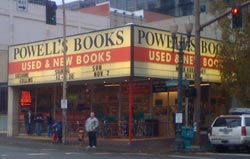My friends at Red Hen Press (publishers of Beneath Stars Long Extinct) have asked me to write a brief article on self-run sites by writers. If you’re a writer or published author and want to get the word out about your writing, a well-conceived site written, run, and updated by you is critical. It should be the go-to place on the Internet for anyone doing research about you. It must be the one-stop resource containing everything you want readers to know about you and your writing.
Your first order of business should be to get your own Internet domain. There’s little excuse these days to not have one. If someone goes to your site and you have an address like http://www.somehost.com/yourname/index.html or, worse, http://www.facebook.com/yourname/, it simply isn’t professional. Ideally, you can secure a domain such as yourname.com. If not, try to go with something which won’t mark you as an amateur. For example, seeing a URL like www.nimbusbutterflypoet.com makes most seasoned readers think this will be a site of bad, amorphous, new age-type poetry. Likewise www.darklordscreeds.com will foretell a site of bad gothic rants against gun control and abusive mothers. These may be unfair, but they are generalizations and associative leaps people will make before they visit your site. You can curtail this loss of traffic before it happens by having a reasonably sober Internet domain.
The next thing to do is find a good Internet Service Provider to host your domain. There are countless ISP businesses willing to take your money every month to host your domain, and all the criteria choosing one is beyond the scope of this article, although I might address it in the future. Do your comparison shopping on the Internet. Beware of cost overages and surcharges if you should be fortunate enough to generate a lot of traffic to your site. Find out these costs above and beyond standard monthly fees. Beware of punitive contracts locking you in for more than a month at a time. Most critically, do they have 24-hour technical support? Vote with your dollars, and move accordingly.
Thanks to blogging engines such as WordPress, it’s quite easy to get your own blog component of your site up and running with a minimum of hassle. If your ISP doesn’t support something like WordPress, it’s time to find a new ISP.
A blog regularly updated on your site will keep your old fans coming back, and generate links so new ones can discover you. If the reason for your site to exist is to get people interested in your writing, keep your blog entries relevant. This should not be the blog where you detail your laundry schedule, or what you did with your best friend over the weekend, or how your spouse cheated on you. You can grab another domain for that kind of public diary writing because, frankly, it’s just not that interesting, especially to people who want information about your new book of poetry or your about-to-be published memoir.
It’s best to keep your blog focused on your writing career and the books you’re promoting. Announcing readings, discussing a recent review you got, and publicly answering reader questions are all legitimate blog posts for a writer’s Web site. Ideally, your blog should support both your book(s) and the topics you write about. For instance, if you’ve published a book about a rock band, a music review of their latest release is a good idea. If your book has nothing to do with music and you feel compelled to write a review of new CD you got, you should try to sell that review to an appropriate publication, and not diffuse the energy and confuse readers of your site. As politicians are fond of saying, stay on target.
I’ve previously written about the dangers of Flash-based sites, and I’m still committed to avoiding it at all costs. One thing I didn’t address in the article “Flash Fatigue” (which you should read if you’re thinking of using a Flash-based site), is how Flash was not developed with mobile computing devices in mind. Flash files are insanely computationally-intensive, and suck up a tremendous amount of clock cycles to run. Did you ever visit a Flash site on your laptop and hear your computer’s internal fans spin-up? The reason that’s happening is because the CPU is working overtime, and it needs to be cooled down. Both of those events require energy in the form of battery power. The limited technology of today’s battery power is the only thing which has kept mobile computing from becoming even more obliquitous in our daily lives. The way Flash sucks battery power is the largest and unspoken reason why Apple has rejected Flash support in iOS devices such as the iPad and the iPhone. Again, if you need more reasons, read “Flash Fatigue.”
Essentials a writer’s site should contain include the following information, each broken out on a separate page:
- A brief biography, including awards and other relevant information.
- A publications page, listing your books, and where readers can get them.
- An events page, listing in chronological order where you’ll be reading publicly.
- A contact page, with your email address, at the very minimum.
- A media page, including links to reviews of your work, articles you’ve published on other sites, and video of you reading or lecturing.
Regarding the design of your site, remember you’re trying to attract readers, not alienate them. Clean design is the way to go. With increasing numbers of Internet users on laptops, iPads, phones, and postage stamp-size monitors, this is more critical than ever. Nothing annoys readers more than overly-wide Web pages. Horizontal scrolling is akin to death in usability practices. Keep your pages to 1000 pixels wide or less.
Confusing background images or textures just make things difficult for readers, like oblique, impenetrable poetry. There’s no reason for this type of design. Avoid textures and too many colors as you would avoid bad writing in what you’re trying to sell.
Lastly, a critical thing to avoid is unconventional navigation. You see this most often in Flash-based sites, but it can be found in HTML, PHP, or other more conventionally-built sites. Scroll bars for windows built within pages are not only a pain to navigate, but they’re ugly and confusing. If you’ve got a blog component, make sure it’s easy to navigate to previous posts. Clarity in your terms for navigation are critical. A link called “About,” should go where readers would think it would: to a bio of the writer, and not to a page about the site.
Common sense, clarity, and brevity are watchwords you need to guide you through constructing your own site. Hit the search engines and examine sites belonging to other writers before you start building your own. Make a list of features you like, and do what you best: write your content before you begin coding or hiring a programmer/designer to do it for you. It will save you countless amounts of revision, and that’s time you should be spending on your real writing.
 The bones of Steve Jobs continue their easy rest, especially since November, when Adobe capitulated by announcing the end of mobile browser Flash development. Not only that, but they have moved their focus onto HTML5, something they should have embraced a long time ago.
The bones of Steve Jobs continue their easy rest, especially since November, when Adobe capitulated by announcing the end of mobile browser Flash development. Not only that, but they have moved their focus onto HTML5, something they should have embraced a long time ago.


 Two weeks ago I was treading the boards for
Two weeks ago I was treading the boards for 
